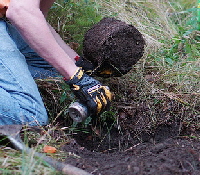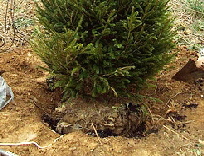How to Plant Evergreens
Just a couple of important steps when planting an evergreen are critical to the health and longevity of your evergreen conifer.
If you're looking to add some year-round greenery to your garden or landscape, evergreens are an excellent option.
Not only do they provide a beautiful backdrop for seasonal flowers and foliage, but they also offer year-round privacy, windbreak, and habitat for birds and other wildlife.
However, planting an evergreen requires careful consideration of the right species, planting time, and site preparation to ensure its health and longevity.
In this article, I'll cover some essential steps for planting evergreens, from selecting the right time to plant and preparing the planting hole to care for your newly planted tree.
Whether you're a seasoned gardener or a first-time planter, these tips will help you get started on creating a thriving evergreen garden.
The Best Time to Plant an Evergreen
Evergreen conifers are hardy trees that can be planted at any time of the year. However, certain seasons offer better conditions for optimal growth.
Planting Evergreens in Early Spring: The Ideal Time
The absolute best time to plant an evergreen conifer is during the early spring when the soil has thawed, and frost is out. This season provides cooler temperatures and plenty of rain, which are perfect conditions for the tree to establish itself. Planting can continue late into the spring as long as the tree is given adequate water.
Late Spring Planting
Late spring is also suitable for planting evergreen conifers, but it's important to ensure the tree receives plenty of water during this time. As the temperature starts to rise, the tree may experience stress, so it's crucial to keep the soil moist to prevent this.
Planting Evergreens in Early Fall
Early fall is another ideal time to plant evergreen conifers, allowing at least 6 to 8 weeks before the soil starts to freeze. During this time, the tree has ample opportunity to become well-established before the heat of summer sets in. It's important to water the tree deeply every week until the ground freezes and to mulch it heavily to prevent heaving during freeze-thaw cycles.
Challenges of Planting During Summer
Summer is the least ideal time to plant evergreen conifers. Even established trees often experience stress during this season, so newly planted trees are particularly vulnerable. The transplant shock and the process of establishing roots require a lot of energy from the tree, making it harder to cope with the heat and drought. Therefore, it's best to avoid planting evergreens during the summer months.
Prepare the Planting Hole for Your Evergreen
Preparing the planting hole is crucial as it loosens the soil, allowing the roots to spread quickly and establish themselves. Evergreens have shallow roots, so it's essential to dig the hole as wide and deep as possible.
Size of the Planting Hole
To ensure adequate space for the roots, the planting hole should be at least two to four times wider than the root ball and at least a foot deep, several inches deeper than the root ball.
Soil Preparation for Evergreens
If you have selected an evergreen that grows well in your local region and soil type, you may not need to amend or enrich the soil. However, if the soil is extremely poor or inappropriate for the tree, you may have to amend it. It's important to avoid filling the hole with too much rich soil as the roots may find it difficult to transition from the hole to the native soil.
Soil Amendments for Improving Drainage or Moisture Retention
Evergreens prefer well-drained but moisture-holding soil. If the soil is sandy, adding a bucket full or two of compost will help retain moisture. If the soil is heavy clay, adding shredded leaves or peat moss will improve drainage. However, it's crucial to use as little amendment as possible to improve the soil.
Caution Against Over-Amending Soil
It's important not to make the planting hole too rich with amendments as it can cause water to accumulate in the hole, leading to root rot. A little improvement goes a long way in helping the tree adjust to the soil conditions.
Planting the Evergreen
Proper planting of evergreens is essential for their growth and development.
Once the hole is prepared, place the container in the hole to check the depth. Adjust the soil level and lightly tamp it to ensure that the top of the root ball is level with the surrounding soil level.
Adjusting the Soil Level and Watering
After checking the depth, return the soil you dug out to the hole, smoothing and lightly firming the soil. Water the soil until it is well soaked. It's essential to adjust the root ball level if it has slightly lowered as the soil settles. Grasp the trunk base and pull it upward gently until the root ball is level with the soil surface. Continue watering, filling, and adjusting the root ball level until the soil has settled evenly.
Importance of Proper Planting Depth
It's crucial not to plant the evergreen too deeply as it may cause early demise. Ensure that the root ball is level with the soil surface and not filled with soil up the trunk. Planting too deeply can also cause water to accumulate at the roots, leading to root rot.
Applying Mulch to Keep Roots Moist
Apply a 2 to 4 inch thick layer of mulch, several inches wider than the widest part of the plant, leaving an inch or two gap to the trunk. Wood or bark mulch, rough trimmings, or rough compost are the best mulches for evergreens. Mulching is essential to keep the roots moist and prevent winter desiccation.
Preventing Damage or Death of Needled Evergreens
Poorly drained soil, planting too deeply, and winter drying are common causes of damage or death of needled evergreens. Therefore, it's essential to plant them in well-drained soil.
Insulating the Roots in Winter
In colder climates, plant the root ball at or slightly below the surrounding soil level and mulch heavily to insulate the roots in winter and prevent heaving in freeze-thaw periods. It's critical to ensure that the soil is well-drained if planting slightly deep. In warmer regions with heavy clay, plant the root ball about an inch above the surrounding soil level to avoid poor drainage problems.
How To Care For Newly Planted Evergreens
Adequate watering is crucial for good root development in evergreens. Slow soak the evergreen each week by moving a slow trickling hose around the perimeter of the root ball over a period of several hours. The aim is to soak the root ball and the surrounding area to encourage roots to move beyond the hole.
Dealing with Transplant Shock in Newly Planted Evergreens
Newly planted evergreens may go through transplant shock, causing the foliage to yellow and needles to drop. This is a natural response as the tree tries to establish itself. Avoid over-watering and fertilizing during the first few months. Allow the plant to adapt to the new conditions for the first season.
Fertilizing Evergreens: Guidelines & Recommendations
Fertilizer is generally unnecessary for mature, established evergreens. Avoid mixing fertilizer into the planting hole as it can cause root damage. Most conifers require no fertilizer at all. However, stressed evergreens may benefit from a light feeding in spring.
Follow the instructions for individual species cultivars, but generally, a light sprinkling of a balanced granular fertilizer in early spring is enough. Fertilizers formulated for evergreens will also improve soil acidity and help keep the needles green.
Protecting Evergreens from Winter Dieback
Winter dieback is common in cold climates, particularly with newly planted evergreens that have not become well-established. To protect young evergreens in the first year or two, wrap them with burlap or erect a sun/wind screen.
Wrapping it Up
In conclusion, planting evergreens can be a great addition to your garden or landscape, providing year-round greenery, privacy, and a habitat for wildlife.
However, careful consideration and preparation are necessary to ensure the health and longevity of the tree.
Selecting the right species, planting time, and preparing the planting hole are crucial steps to take.
Adequate watering, mulching, and protecting the tree from winter dieback are also essential for its growth and development.
With these tips, gardeners can create a thriving evergreen garden that adds beauty and value to your property.
Next Page Tips for Planting Different Types of Nursery Stock


